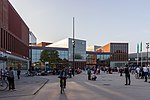FiR 1

FiR 1 (Finland Reactor 1; also sometimes referred to as Otaniemi research reactor, Otaniemi reactor, TKK reactor or VTT reactor) was Finland's first nuclear reactor. It was a research reactor that was located in the Otaniemi campus area in the city of Espoo. The TRIGA Mark II reactor had a thermal power of 250 kilowatts. It started operation in 1962, and it was permanently shut down in 2015. At first, the reactor was operated by Helsinki University of Technology (TKK), and since 1971 by VTT Technical Research Centre of Finland.In addition to research, the reactor was used for production of radioactive isotopes for industrial measurements. It was used also for neutron activation analysis of geological and biological materials. Lunar soil samples from Apollo 12 were analyzed with FiR 1. Radiation damage to equipment has been investigated with the reactor. For example, magnetometers for the ITER fusion reactor have been irradiated with FiR 1. University students have performed exercises with the reactor. After the year 2000, the most significant use of the reactor was boron neutron capture therapy for patients with a cancer in the head or neck area.
Excerpt from the Wikipedia article FiR 1 (License: CC BY-SA 3.0, Authors, Images).FiR 1
Otakaari, Espoo Otaniemi (Suur-Tapiola)
Geographical coordinates (GPS) Address Phone number Website Nearby Places Show on map
Geographical coordinates (GPS)
| Latitude | Longitude |
|---|---|
| N 60.1877 ° | E 24.830947222222 ° |
Address
Aalto-yliopisto
Otakaari 24
02150 Espoo, Otaniemi (Suur-Tapiola)
Finland
Open on Google Maps










